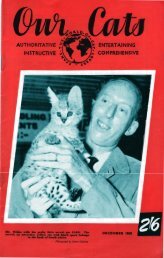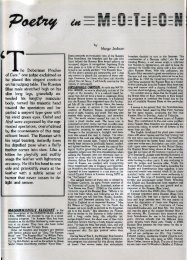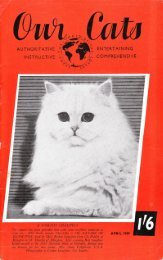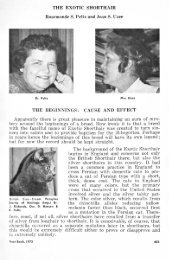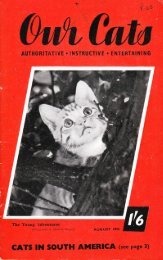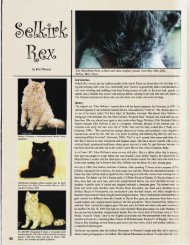Mrs. Norah Andrews - Kyina & Talisker Cats Breeders of Russian ...
Mrs. Norah Andrews - Kyina & Talisker Cats Breeders of Russian ...
Mrs. Norah Andrews - Kyina & Talisker Cats Breeders of Russian ...
Create successful ePaper yourself
Turn your PDF publications into a flip-book with our unique Google optimized e-Paper software.
Association with a Fish Diet.-The condition has long beencalled " fish eczefna " becauseaffected cats usually have analmost exclusive diet <strong>of</strong> fish. Onenquiry <strong>of</strong> orvners <strong>of</strong> non-afi^ectedcats, however, it is found thatmost cats are fed almcst entirelr"on fish.Evidence against fislr as a contributorycause was as follor,r,s :-Six affected cats received n<strong>of</strong>ish whatsoever.Six affected cats receir.ed fishonly occasionally.Affected cats were cured \rhilereceiving an entirely fish diet.Fleas are the Cause ?.Association with Ectoparasites.-Out <strong>of</strong> 76 cases it was possible todemonstrate flea inlestation in 61instances, representing 80.2 percent. In four cases the owner hadtwo cats ; one affected and onenormal. In every instance thenon-affected cat carried greatnumbers <strong>of</strong> fleas but the ownersstated that these animals never" washed " themselves, rvhereasthe affected cats were " rvashing "continually. The diet in eachcase consisted almost entirel,v <strong>of</strong>fish.Five fleas were released into thecoat <strong>of</strong>an ll-year-oid cat whichwas known to have been free <strong>of</strong>fleas all its life, which had neverhad skin trouble, and whichreceived a diet consistins enrirelv<strong>of</strong> fish. Within f.". t;.;k;";ianimal developed a typical severeeczema. Two weeks after the cathad been dusted with an insecticidethe coat became normal, andit remained normal. This experimentwill have to be repeatedbefore conclusions can be reached.In the meantime. however, incats there is er-en str:.:=: =..:-ence than in llre "a.e : .... : {that the lesions ol erzc::... .:r eself-inflicted and that f,ea. :.:ethe cause <strong>of</strong> rhe irritation.Treatment.-The use <strong>of</strong> insecticidessuch as BHC dust was theonlv treatment advised in all theforegoing cases. The o\\'ners\\:ere encollraged to continue givingan entirely fish diet. Removal<strong>of</strong> the flea does not bring aboutan immediate recoverv in the catbecause a r-icior-rs circie has beenset up and the animal continuesto lick the lesions. The averagecase took three to five weeks toclear r-rp. In some cases the fleashad returned to the animal in aremarkably short time and thecondition continued. Where insecticideswere used at regularintervals cats which had beenchronic cases remained free fbryears.Sumntarl. The relationship betr'veeneczema in the cat and a fishdiet is discussed. There is strongevidence to suggest that it is notassociated l'ith a fish diet. Positions<strong>of</strong> lesions \\'ere alwavs withinreach <strong>of</strong> the rough tongue or theclarrs and 80.2 oer cent. <strong>of</strong> catsnarboured ectoparasltes.BO'SUNThose <strong>of</strong> our readers who havebeen following the adventures <strong>of</strong> theSailor Siamese will be interested toknow that we have recently receivednews from the Mediterranean. The" Mary Hillier t' is afloat again andBo'sun has been visiting Algiers. Wehope to be able to resume DeeBlackburnts narrative in our Januaryissue.



